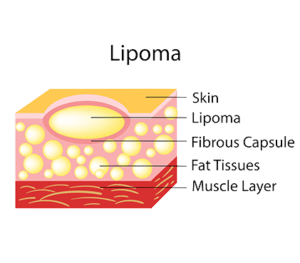Multiple Lipoma Treatment
Lipoma Treatment is typically depends on their size, location, and the level of discomfort they cause. In many cases, medical intervention may not be necessary, and a “watch and wait” approach is adopted. However, when treatment is sought, surgical removal is the primary option. This procedure involves making an incision, removing the lipomas, and suturing the wound.
Liposuction is another viable option, particularly for smaller lipomas. This minimally invasive technique suctions out the fatty tissue through a small tube. Additionally, steroid injections can be used to reduce inflammation and size, but they may not eliminate the lipomas entirely.
In some cases, lipomas may recur after treatment, necessitating further procedures. While rare, malignant transformations of lipomas can occur, making it crucial to monitor and consult a healthcare professional for proper evaluation and treatment recommendations. Ultimately, the choice of treatment should be a collaborative decision between the patient and their healthcare provider.
TALK TO OUR EXPERT
What is Lipoma?
A lipoma is a benign, non-cancerous growth of fatty tissue that typically develops just beneath the skin. These slow-growing lumps are among the most common soft tissue tumors in adults and can occur anywhere on the body where fat cells are present. Lipomas are usually painless and feel soft to the touch, often moving easily when pressed upon.
The exact cause of lipomas remains unclear, although they tend to run in families, suggesting a genetic predisposition. Some medical conditions, such as Gardner’s syndrome or adiposis dolorosa, can also increase the likelihood of developing lipomas. These growths are most commonly found in middle-aged adults but can occur in individuals of all ages.
Lipomas are generally harmless and do not require treatment unless they become painful, grow excessively large, or cause cosmetic concerns. In such cases, surgical removal is an option. However, lipomas have a tendency to recur after removal in some cases.
While lipomas are usually not a cause for concern, it’s essential to differentiate them from other types of growths like cysts or tumors. If you notice any unusual lumps or changes in your body, it’s advisable to consult a healthcare professional for a proper evaluation and diagnosis.
Care After Lipoma Treatment
After undergoing lipoma treatment, it’s important to follow specific care guidelines to ensure a smooth recovery and minimize complications. Here are essential post-treatment care considerations:
- Wound Care: If surgical removal was performed, keep the wound clean and dry. Follow your healthcare provider’s instructions for changing dressings and keeping the incision site sterile. Report any signs of infection, such as redness, swelling, or discharge, promptly.
- Pain Management: You may experience some discomfort or pain following surgery. Your doctor may prescribe pain medications or recommend over-the-counter pain relievers as needed.
- Activity: Rest and limit strenuous activities for the recommended period to aid healing and prevent complications. Gradually increase your activity level as advised by your healthcare provider.
- Scar Care: Proper wound care can help minimize scarring. Use scar creams or silicone sheets, as recommended by your surgeon, to promote better healing and reduce the appearance of scars.
- Follow-Up: Attend all scheduled follow-up appointments with your healthcare provider to monitor your recovery and address any concerns.
- Lifestyle: Maintain a healthy lifestyle with a balanced diet and regular exercise to promote overall well-being.
Remember to consult your healthcare provider for personalized guidance and to address any post-treatment questions or concerns.
Common Areas for Lipoma
- Neck and Shoulders
- Lipomas frequently develop in the neck and shoulder region.
- They can be particularly noticeable in these areas due to their proximity to the surface.
- Arms and Forearms
- Lipomas can form in the upper arms and forearms.
- They may be mistaken for muscle knots or soft tissue masses.
- Torso
- Lipomas are known to appear on the trunk or torso, including the chest and back.
- They might be discovered during routine self-examinations or physicals.
- Thighs and Hips
- Lipomas can be found on the thighs and hips, often beneath the skin.
- Their presence may cause discomfort when walking or sitting.
- Buttocks
- Lipomas can occasionally develop in the buttocks.
- Larger lipomas in this area may be noticeable and bothersome.
- Forehead and Scalp
- Although less common, lipomas may form on the forehead or scalp.
- These are usually small and can be concealed by hair.
- Armpits
- Lipomas can occur in the armpits, causing discomfort or cosmetic concerns.
- Surgical removal may be considered in such cases
Benefits of Lipoma Treatment
- Symptom Relief: Lipoma treatment can alleviate symptoms such as pain, discomfort, and cosmetic concerns associated with these benign fatty lumps.
- Improved Mobility: When lipomas grow in areas that impede movement, their removal can enhance mobility and flexibility.
- Enhanced Appearance: Surgical removal or liposuction can improve the aesthetic appearance of the skin, boosting self-confidence.
- Prevent Complications: Treating lipomas helps prevent potential complications like infection, nerve compression, or interference with adjacent structures.
- Psychological Well-being: Treatment can alleviate anxiety or distress caused by the presence of lipomas, leading to improved mental health.
- Prevent Recurrence: Some treatments aim to reduce the likelihood of lipoma recurrence, providing long-term relief.
- Diagnostics: Biopsy or examination during treatment can confirm the lump’s benign nature, ruling out malignancy.
- Quick Recovery: Most lipoma treatments are outpatient procedures with minimal downtime, allowing patients to resume their regular activities relatively quickly.
- Peace of Mind: Knowing that the lipoma has been treated and evaluated reduces worry about its potential growth or complications.
- Customized Care: Treatment plans are tailored to individual needs, ensuring optimal outcomes and patient satisfaction.




